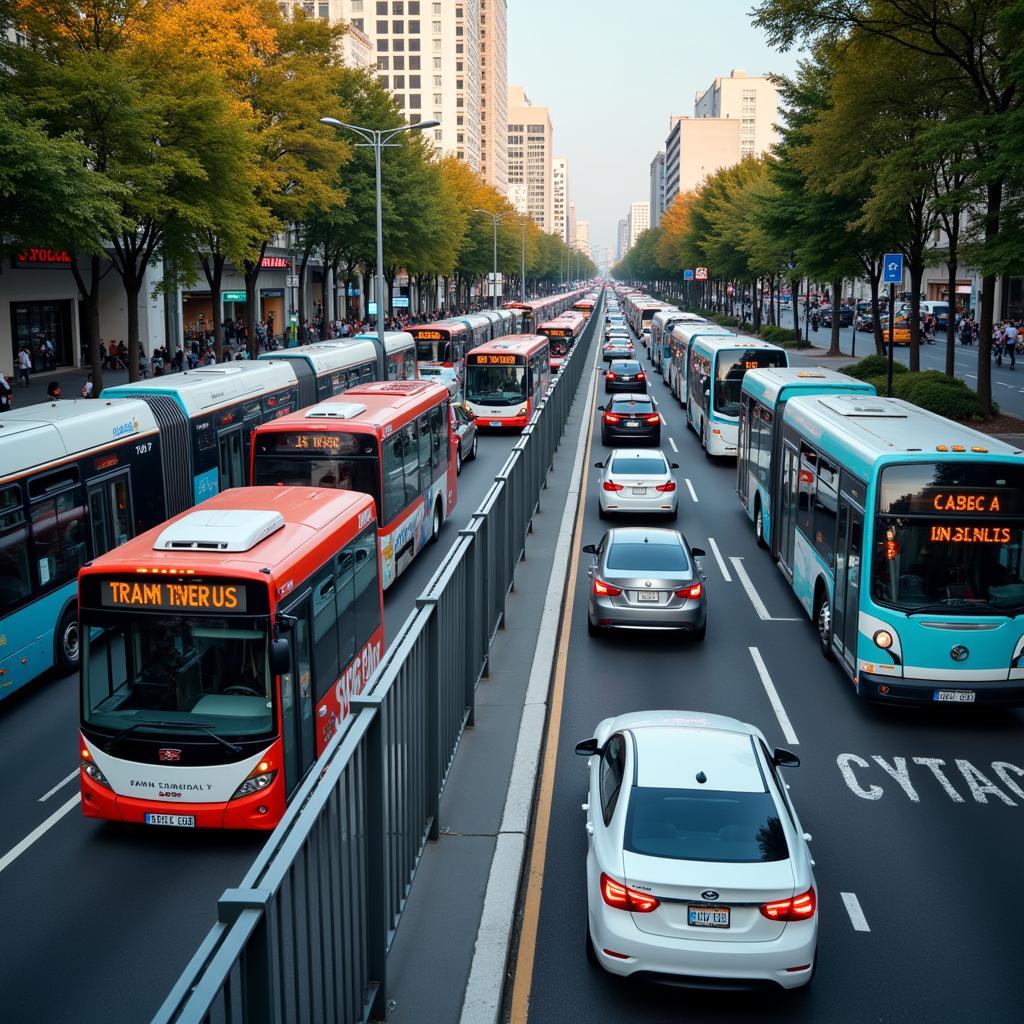Transportation has consistently been a prominent topic in IELTS Writing Task 2, appearing in approximately 15% of actual test questions between 2020-2023. This frequency suggests it will remain relevant in future examinations. Let’s explore the pros and cons of offering free public transportation through actual test questions and model answers.

Task Analysis
Some people believe that private car usage should be restricted in city centers, while others think people should be free to use their cars. Discuss both views and give your opinion.
This question requires:
- Discussing arguments for and against car restrictions
- Providing a clear personal stance
- Supporting ideas with relevant examples
- Following a balanced approach
Band 8.5 Model Answer
Urbanization has sparked debate about whether personal vehicles should be limited in metropolitan cores. While some advocate for restrictions, others support unrestricted car usage. In my view, implementing reasonable limitations on private vehicles is crucial for sustainable urban development.
Proponents of car restrictions present compelling arguments. Firstly, reducing private vehicles significantly decreases air pollution and carbon emissions, as demonstrated in cities like Amsterdam and Copenhagen. Additionally, car-free zones create more space for pedestrians and cyclists, enhancing the overall quality of urban life. For instance, when Madrid implemented car restrictions in its central district, air quality improved by 30% within a year.
Conversely, those opposing restrictions argue that private cars provide essential convenience and flexibility. Many people, particularly the elderly or those with disabilities, rely heavily on personal vehicles for mobility. Furthermore, some contend that restrictions could negatively impact businesses in city centers, as reduced accessibility might deter potential customers.
Should electric vehicles replace gasoline-powered cars? This question becomes increasingly relevant as we consider solutions. I believe that while complete car bans might be impractical, implementing strategic restrictions alongside improved public transportation offers the best path forward. Cities could introduce congestion pricing, expand park-and-ride facilities, and create more pedestrian zones while ensuring accessibility for those who truly need vehicle access.
In conclusion, while both perspectives have merit, careful implementation of car restrictions, combined with enhanced alternative transportation options, represents the most sustainable approach to urban mobility.
Band 7.5 Model Answer
The debate over private car usage in city centers has become increasingly important as urban areas grow. This essay will examine both viewpoints and provide my perspective on this matter.
Those supporting car restrictions argue that limiting private vehicles would reduce traffic congestion and environmental pollution. Many cities have successfully implemented such policies – for example, Singapore’s vehicle quota system has effectively managed traffic flow. Moreover, restrictions encourage people to use public transportation, which is more environmentally friendly.
However, opponents claim that car restrictions infringe on personal freedom and convenience. They argue that many people need cars for work or family responsibilities. Small business owners often require vehicles to transport goods, and families with young children may find public transportation challenging.
In my opinion, a balanced approach is necessary. While complete car bans might be excessive, introducing moderate restrictions like congestion charges or limited-traffic zones could help manage vehicle usage effectively. These measures should be accompanied by improved public transportation infrastructure.
To conclude, while both arguments have validity, I believe implementing reasonable car restrictions while ensuring adequate alternatives represents the most practical solution.
Band 6.5 Model Answer
Nowadays, many people debate about cars in city centers. Some people want to stop cars, but others want to use them freely. I will discuss both sides and give my opinion.
First, people who want to stop cars have good reasons. Cars make pollution and traffic jams. When there are too many cars, the air becomes dirty and people waste time in traffic. Also, cars take up lots of space that could be used for parks or walking areas.
But other people say we need cars. They think it’s not fair to stop people from using their cars. Some people live far from work and need cars. Also, old people and disabled people need cars to move around easily.
I think both sides make good points, but we should have some rules for cars. Maybe we can make some areas car-free and improve buses and trains. This way, people can still use cars when they need them, but there will be less traffic and pollution.
In conclusion, we should find a balance between letting people use cars and protecting our cities from too many vehicles.
Key Vocabulary
- urbanization (n) /ˌɜːrbənaɪˈzeɪʃən/ – the process of towns growing larger
- congestion (n) /kənˈdʒestʃən/ – overcrowding, especially of traffic
- infrastructure (n) /ˈɪnfrəstrʌktʃər/ – basic physical structures needed for society
- quota system (n) /ˈkwoʊtə ˈsɪstəm/ – fixed number or percentage allowed
- infringe (v) /ɪnˈfrɪndʒ/ – to break or violate
- sustainable (adj) /səˈsteɪnəbəl/ – able to continue over time without damaging the environment
- pedestrian (n) /pəˈdestriən/ – person walking in a street
- mobility (n) /moʊˈbɪləti/ – ability to move freely
Remember to practice writing your own essay on this topic and share it in the comments for feedback. Future IELTS tests might feature similar questions about environmental impacts of transportation or urban planning policies.